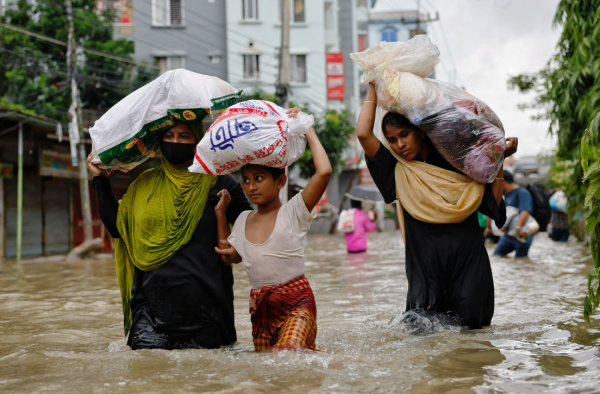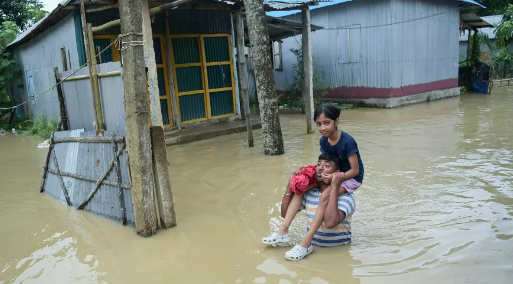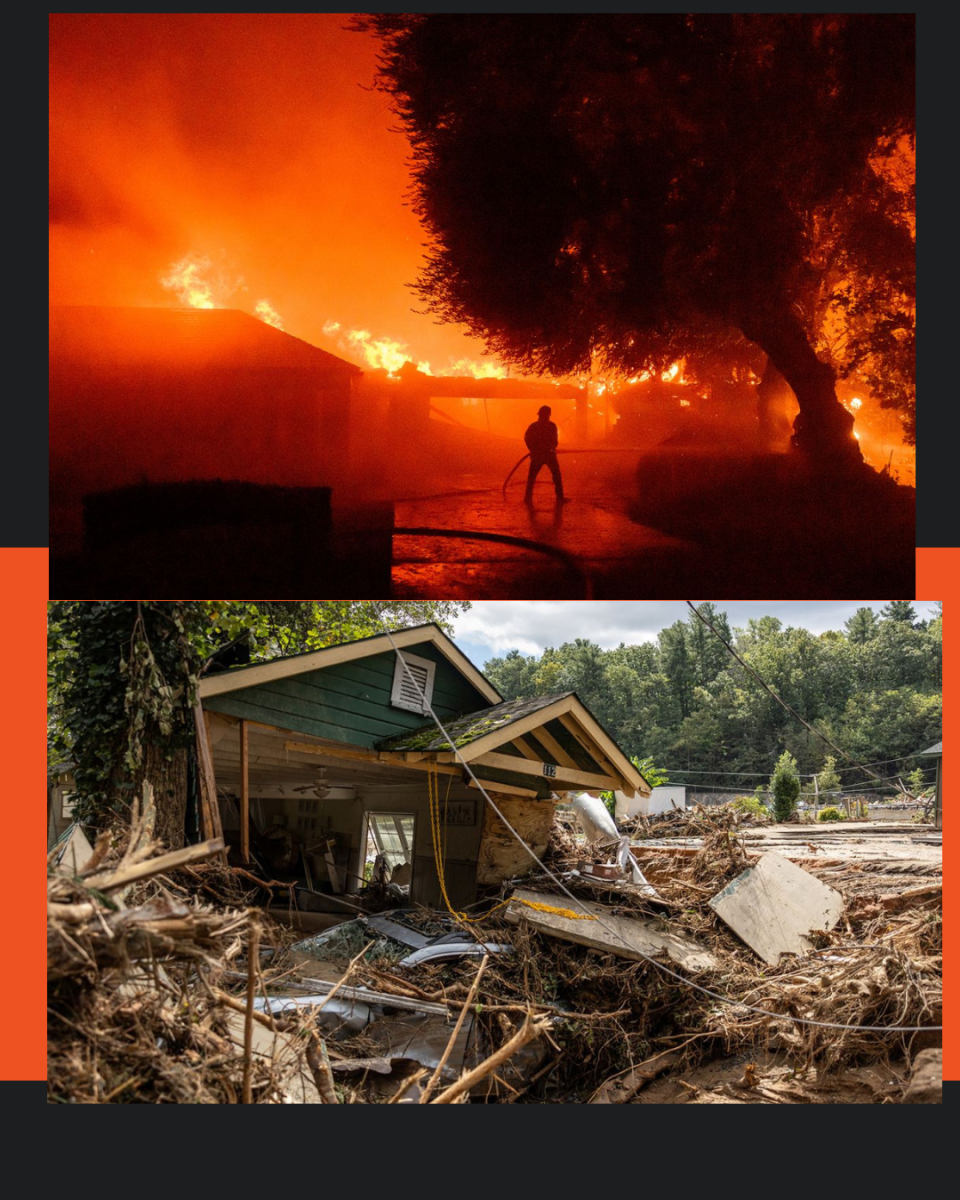
Summer is the typical “hurricane season” for countries all over the world, so heavy rain is expected, but it usually entails no more than the usual brief warning of “Stay inside and carry an umbrella!” At least in the United States, summertime isn’t severely affected by rainstorms, except for an occasional hurricane. But for countries in Asia, specifically Bangladesh, this summer’s weather had a lasting impact on the local communities and families like never before.
From late June to early August, a series of abrupt rainstorms combined with strong monsoon winds led to the overflow of rivers surrounding northeastern Bangladesh. Most prominently, millions were left stranded and at risk of malnutrition.
According to the New York Times article “Deadly Floods Strike Troubled Bangladesh” by Saif Hasnat, floods were said to have left about 90 percent of homes “flooded with knee-high water.” With water levels up to ten feet, thousands of residents were left with irreparable damage to their homes. The deluge caused thousands of families to be displaced from their homes, leaving them stranded. Due to the uninhabitable conditions of their homes, Bangladeshis have had to seek refuge in shelters; however, there have been an insufficient number of shelters set up.
As an immediate response, organizations like UNICEF, the Central Emergency Response Fund (CERF), the Humanitarian Coordination Task Team (HCTT), and the Bangladeshi government set up shelters and emergency kits and donated money to families to help locals recover from the flood as quickly as possible. UNICEF has provided filtered drinking water and basic hygiene supplies; such as toothbrushes, toothpaste, soap, towels, etc.
Aside from housing, excessive damage was done to the crops and livestock of northeastern Bangladesh. Maryanne Buechner, author of “Floods in Bangladesh: How UNICEF is Delivering Relief & Protection to Children,” states that “over half of the Sylhet district’s crops and fields are submerged, threatening livelihoods and food security.” Fields have been flooded and entirely wiped out by the large rushes of water, which has led to many families being on the verge of malnutrition. Bangladesh is a third-world country and is heavily dependent on agriculture since many of the locals are farmers and rely on an abundance of crops to make a living. The damaged goods have a lasting impact on workers and their income, as well as the families they sell food to. Locals are left without rice, corn, and other nutritious vegetables and foods that are necessary for a balanced diet.


The floodings in Bangladesh are something that affect millions every year. It’s a continuous challenge that locals have yet to overcome and each year the outcome is the same; families are left without shelter, crops are destroyed, and communities have a hard time getting back on their feet after the natural disaster strikes.













Felipe Da SIlveira • Dec 16, 2024 at 8:56 am
This is a reminder of nature’s fury and the urgent need for solidarity. The devastating floods in Bangladesh have left millions grappling for their lives.
Lucas Vaca Narvaja • Dec 15, 2024 at 11:33 am
The deluge has disastrous impacts. It does not stand outside natural calamity effects; actually, it is more part of a human disaster. Homes are lost, fields are drowned, and livelihood is lost. Such efforts by UNICEF and some of the organizations are commendable although… such sheer destruction stands above most short-term relief. Sustainable solutions to better flood management and resilient-supporting agriculture will put the nails in this cyclical loaf of suffering and losses. Wow, what a nice story to read!
James Sobel • Dec 12, 2024 at 9:41 pm
Once I read this article, it immediately brought a sense of melancholy. I learned that from June to August Bangladesh saw extreme drought, resulting in flooding from rain and monsoon winds. About 90% of homes were flooded, with water levels reaching up to ten feet. As a result, organizations like UNICEF have provided emergency aid, including water and other supplies. One rhetorical device I found was an appeal to pathos. This emotional appeal is used to evoke sympathy and concern for people in Bangladesh.
Ryan Kessner • Dec 12, 2024 at 3:44 pm
Nice work! I liked how your article powerfully highlights the devastating impact of the floods in Bangladesh, showing how nature’s fury can suspend millions of lives. The sheer scale of damage—from submerged homes to ruined crops—underscores the vulnerability of communities dependent on agriculture. It’s a reminder that while the world watches from a distance, resilience and global support remain huge for things like recovery, much like a lighthouse guiding ships through a relentless storm.
Lex • Dec 11, 2024 at 11:55 am
This is so interesting I didn’t even know that this tragedy had struck Bangladesh. I hope that UNICEF and CERF can help the people of Bangladesh as much as possible, so we in Florida can sympathize with the people in Bangladesh because Florida gets hit with heavy storms and hurricanes as well.
tyler s. • Nov 14, 2024 at 11:42 am
Tragic story! tragedies like this don’t happen every day and I’m glad to see other little newspaper give these stories the light of day. all thoughts and prayers to the people of Bangladesh.
Andrea Lugo • Nov 13, 2024 at 7:58 am
its very sad how much people are suffering due to the flood I thank that boca is not flooded
mya • Nov 12, 2024 at 11:45 am
After reading this, I feel bad for everyone affected by the floods.I can’t imagine this ever happening to me, and I feel compassion for those whose homes were destroyed.
Hailey • Nov 12, 2024 at 9:40 am
It is so unfortunate that people in other countries go through this, and also do not have the proper resources and supplies to fix a lot of the problems caused by hurricanes like the U.S has.
Noah • Nov 12, 2024 at 8:55 am
That’s sad how many people lost their homes to the storm. But it’s good that they have homeless shelters to go to
Max • Nov 12, 2024 at 8:14 am
These floods are terrible for the people of Bangladesh. I can’t imagine losing all your crop and livestock that keeps you fed because of an unstoppable natural phenomenon.
lianna • Nov 12, 2024 at 8:10 am
its a sad article, but provides a lot of information, and shows ways people help. its a really good article and spreads awareness
amarah • Nov 12, 2024 at 12:06 am
this article is very well written. The tone is formal and gives a lot of information.
nadia • Nov 11, 2024 at 1:35 pm
This article clearly provides lots of information,it was very unfortunate for the people in Bangladesh. But, it’s good that some people provide organizations that provide shelters and other essentials for bad weather conditions.
mark • Nov 11, 2024 at 11:57 am
it’s really sad to think that stuff like this is happening while we complain out stupid stuff I feel so bad for those people and wish them the best
Joel Mizrachi • Nov 11, 2024 at 11:45 am
It’s sad how many people had their homes destroyed due to flooding. Northeastern Bangladesh seems like a hard place to live, and it’s especially saddening how people who work as farmers had their stock of crops and thus most of their potential earnings destroyed. Good article that spreads awareness of the harm of natural disasters around the world.
Nathaly • Nov 11, 2024 at 11:38 am
By reading this article I can see how these floods have a bad effect on people that live in Bangladesh. It is very heartbreaking seeing all these people struggling because of something that can’t be prevented.
Alma Calev • Nov 11, 2024 at 11:25 am
i think it’s a really great article, It’s so sad that the weather effect’s people’s life that bad.
Brielle Crawley • Nov 11, 2024 at 11:21 am
I had no idea that flooding was so devastating in places like this. the writing is very imformative and the picture of the young girl on the mans shoulders is very pathos filled and devastating
ari • Nov 11, 2024 at 11:21 am
such a sad but needed story I hope everyone gets help. I’m glad this was brought to my attention
Izzy • Nov 11, 2024 at 11:18 am
I enjoyed reading this story, and learning more information on the floods in Bangladesh. I feel really horrible for everyone who has been affected, and I’m happy to hear that there are organizations that are helping.
Deangelo Barrera • Nov 11, 2024 at 9:55 am
It is unfortunate how this flooding has affected the people of Bangladesh. Thankfully, organizations such as UNICEF have been able to provide life-saving aid.
Catherine • Nov 10, 2024 at 10:06 pm
Great story ! It’s really heartbreaking to see how these weather problems can have such horrible effects on people’s lives. They are also so unpredictable and can’t be prevented. Sending much love to the people affected by the flooding in Bangladesh.
brianna • Nov 10, 2024 at 7:41 pm
This article clearly shows and provides a lot of information was very unfortunate for the people in Bangladesh. However, it’s good that some people provide organizations that provide shelters and other necessities for bad weather conditions.
ngan • Nov 10, 2024 at 1:10 pm
Natural disasters are so terrible and it is very sad how it leads to countless people suffering. I’m glad this article is bringing awareness to how much of an impact they can have
Leah • Nov 9, 2024 at 8:26 pm
It is horrible that so many people living in Bangladesh no longer have homes. The organizations like UNICEF and the Central Emergency Response Fund (CERF) are very helpful because they are providing shelters and emergency kits.
el • Nov 8, 2024 at 12:08 pm
Weather problems can cause so much destruction everywhere and people will leave if they can before it happens. Floods are very destructive and hurricanes are too. It is so sad to see so many people going through so much because of stuff like this happening.
marissa • Nov 8, 2024 at 12:05 pm
this is so sad! i cant imagine having to deal with flooding you haven’t ever prepared for.
Maxim Makushkin • Nov 8, 2024 at 11:58 am
Very informative article. I wish good luck to locals.
Mattias • Nov 8, 2024 at 11:57 am
Usually we complain about the hurricanes and flooding here but clearly Bangladesh has it much worse. Thankfully we don’t have it as bad here.
Lara • Nov 8, 2024 at 11:52 am
This is a great story! it’s so depressing how much damage a natural disaster can bring.
Brianna Williams • Nov 8, 2024 at 11:39 am
I had no Idea that Summer time is Hurricane season. I find it crazy that 90 percent of the homes were flooded with knee high water.
Audrey H • Nov 8, 2024 at 11:28 am
Aww praying for Bangladesh. Thank you for sharing this.
max • Nov 8, 2024 at 11:26 am
I hope that Bangladesh can recover from these floods that damaged communities.
Kyle • Nov 8, 2024 at 11:23 am
It’s so unfortunate that people’s entire lives can be flipped upside down so rapidly. I’m glad organizations like UNICEF and CERF are able to set up shelters and help supply victims of these storms with food and hygiene supplies.
Giada • Nov 8, 2024 at 11:21 am
The amount of monsoon windsand abrupt rainstorms were unfortunate lots of people were left stranded. I also noticed with the amount of high water many people were left without homes which is sad.
chase • Nov 8, 2024 at 11:20 am
That flooding must be terrifying. Very well written.